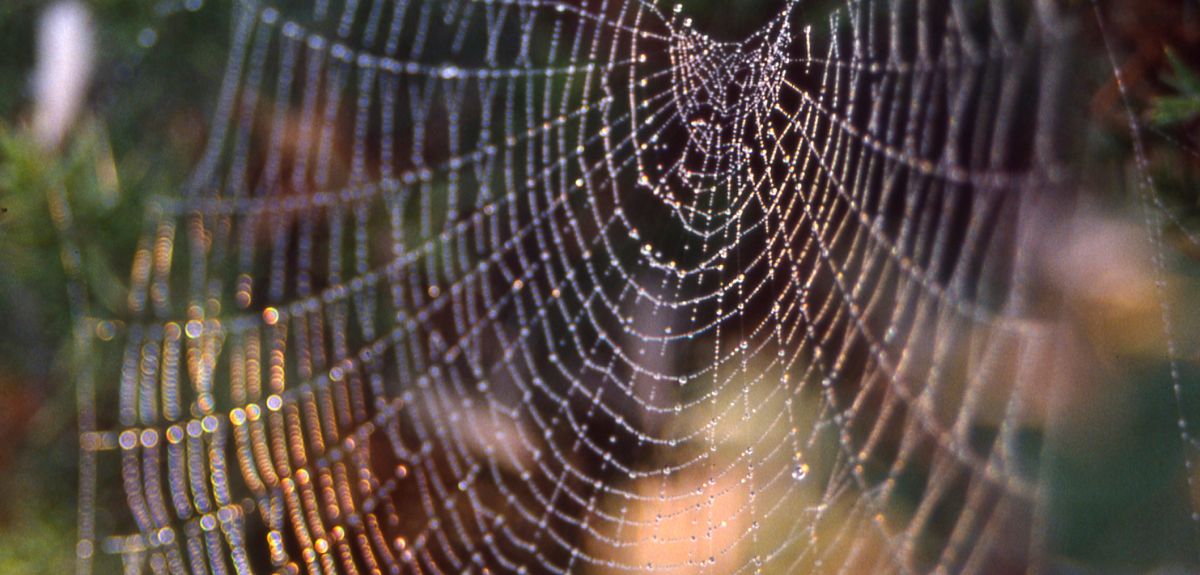
Spiders know the meaning of web music
Spider silk transmits vibrations across a wide range of frequencies so that, when plucked like a guitar string, its sound carries information about prey, mates, and even the structural integrity of a web.
The discovery was made by researchers from the Universities of Oxford, Strathclyde, and Sheffield who fired bullets and lasers at spider silk to study how it vibrates. They found that, uniquely, when compared to other materials, spider silk can be tuned to a wide range of harmonics. The findings, to be reported in the journal Advanced Materials, not only reveal more about spiders but could also inspire a wide range of new technologies, such as tiny light-weight sensors.
'Most spiders have poor eyesight and rely almost exclusively on the vibration of the silk in their web for sensory information,' said Beth Mortimer of the Oxford Silk Group at Oxford University, who led the research. 'The sound of silk can tell them what type of meal is entangled in their net and about the intentions and quality of a prospective mate. By plucking the silk like a guitar string and listening to the ‘echoes’ the spider can also assess the condition of its web.'
This quality is used by the spider in its web by 'tuning' the silk: controlling and adjusting both the inherent properties of the silk, and the tensions and interconnectivities of the silk threads that make up the web. To study the sonic properties of the spider's gossamer threads the researchers used ultra-high-speed cameras to film the threads as they responded to the impact of bullets. In addition, lasers were used to make detailed measurements of even the smallest vibration.
'The fact that spiders can receive these nanometre vibrations with organs on each of their legs, called slit sensillae, really exemplifies the impact of our research about silk properties found in our study,' said Dr Shira Gordon of the University of Strathclyde, an author involved in this research.
'These findings further demonstrate the outstanding properties of many spider silks that are able to combine exceptional toughness with the ability to transfer delicate information,' said Professor Fritz Vollrath of the Oxford Silk Group at Oxford University, an author of the paper. 'These are traits that would be very useful in light-weight engineering and might lead to novel, built-in 'intelligent' sensors and actuators.'
Dr Chris Holland of the University of Sheffield, an author of the paper, said: 'Spider silks are well known for their impressive mechanical properties, but the vibrational properties have been relatively overlooked and now we find that they are also an awesome communication tool. Yet again spiders continue to impress us in more ways than we can imagine.'
Beth Mortimer said: 'It may even be that spiders set out to make a web that 'sounds right' as its sonic properties are intimately related to factors such as strength and flexibility.'
 Silk during high-rate ballistic impact
Silk during high-rate ballistic impactThe work was conducted by researchers from the Oxford Silk Group, along with collaborators at Oxford's Department of Engineering Science, Strathclyde's Centre for Ultrasonic Engineering, and Sheffield's Department of Materials Science and Engineering. The research was supported by The Leverhulme Trust, EPSRC, and BBSRC.
A report of the research, entitled 'The Speed of Sound in Silk: Linking Material Performance to Biological Function', is to be published online in the journal Advanced Materials.
 New study estimates NHS England spends 3% of its primary and secondary care budget on the health impacts of temperature
New study estimates NHS England spends 3% of its primary and secondary care budget on the health impacts of temperature
 International collaboration launches largest-ever therapeutics trial for patients hospitalised with dengue
International collaboration launches largest-ever therapeutics trial for patients hospitalised with dengue
 Oxford-built multi-agent assistant for cancer care to be piloted in collaboration with Microsoft
Oxford-built multi-agent assistant for cancer care to be piloted in collaboration with Microsoft
 World's first Phase II Nipah virus vaccine trial launch
World's first Phase II Nipah virus vaccine trial launch